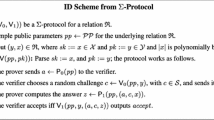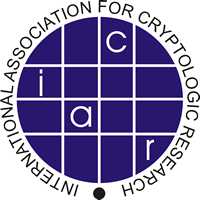Abstract
Bounded IND-CCA security (IND-qCCA) is a notion similar to the traditional IND-CCA security, except the adversary is restricted to a constant number q of decryption/decapsulation queries. We show in this work that IND-qCCA is easily obtained from any passively secure PKE in the (Q)ROM. That is, simply adding a confirmation hash or computing the key as the hash of the plaintext and ciphertext holds an IND-qCCA KEM. In particular, there is no need for derandomization or re-encryption as in the Fujisaki-Okamoto (FO) transform [15]. This makes the decapsulation process of such IND-qCCA KEM much more efficient than its FO-derived counterpart. In addition, IND-qCCA KEMs could be used in the recently proposed KEMTLS protocol [29] that requires IND-1CCA ephemeral key-exchange mechanisms, or in TLS 1.3. Then, using similar proof techniques, we show that CPA-secure KEMs are sufficient for the TLS 1.3 handshake to be secure, solving an open problem in the ROM. In turn, this implies that the PRF-ODH assumption used to prove the security of TLS 1.3 is not necessary and can be replaced by the CDH assumption in the ROM. We also highlight and briefly discuss several use cases of IND-1CCA KEMs in protocols and ratcheting primitives.
Access this chapter
Tax calculation will be finalised at checkout
Purchases are for personal use only
Similar content being viewed by others
References
OQS OpenSSL (June 2021). https://github.com/open-quantum-safe/openssl
Balli, F., Rösler, P., Vaudenay, S.: Determining the core primitive for optimally secure ratcheting. In: Moriai, S., Wang, H. (eds.) ASIACRYPT 2020. LNCS, vol. 12493, pp. 621–650. Springer, Cham (2020). https://doi.org/10.1007/978-3-030-64840-4_21
Bindel, N., Brendel, J., Fischlin, M., Goncalves, B., Stebila, D.: Hybrid key encapsulation mechanisms and authenticated key exchange. In: Ding, J., Steinwandt, R. (eds.) PQCrypto 2019. LNCS, vol. 11505, pp. 206–226. Springer, Cham (2019). https://doi.org/10.1007/978-3-030-25510-7_12
Bindel, N., Hamburg, M., Hövelmanns, K., Hülsing, A., Persichetti, E.: Tighter proofs of CCA security in the quantum random oracle model. In: Hofheinz, D., Rosen, A. (eds.) TCC 2019. LNCS, vol. 11892, pp. 61–90. Springer, Cham (2019). https://doi.org/10.1007/978-3-030-36033-7_3
Brendel, J., Fischlin, M., Günther, F., Janson, C.: PRF-ODH: Relations, instantiations, and impossibility results. Cryptology ePrint Archive, Report 2017/517 (2017). https://ia.cr/2017/517
Brendel, J., Fiedler, R., Günther, F., Janson, C., Stebila, D.: Post-quantum asynchronous deniable key exchange and the signal handshake. Cryptology ePrint Archive, Report 2021/769 (2021). https://eprint.iacr.org/2021/769
Celi, S., et al.: Implementing and measuring KEMTLS. Cryptology ePrint Archive, Report 2021/1019 (2021). https://ia.cr/2021/1019
Cramer, R., et al.: Bounded CCA2-secure encryption. In: Kurosawa, K. (ed.) ASIACRYPT 2007. LNCS, vol. 4833, pp. 502–518. Springer, Heidelberg (2007). https://doi.org/10.1007/978-3-540-76900-2_31
Crockett, E., Paquin, C., Stebila, D.: Prototyping post-quantum and hybrid key exchange and authentication in TLS and SSH. IACR Cryptol. ePrint Arch. 2019, 858 (2019)
Davis, H., Günther, F.: Tighter proofs for the SIGMA and TLS 1.3 key exchange protocols. In: Sako, K., Tippenhauer, N.O. (eds.) ACNS 2021. LNCS, vol. 12727, pp. 448–479. Springer, Cham (2021). https://doi.org/10.1007/978-3-030-78375-4_18
Diemert, D., Jager, T.: On the tight security of TLS 1.3: theoretically sound cryptographic parameters for real-world deployments. J. Cryptol. 34(3), 1–57 (2021)
Dowling, B., Fischlin, M., Günther, F., Stebila, D.: A cryptographic analysis of the TLS 1.3 handshake protocol. J. Cryptol. 34 (2020)
Fluhrer, S.: Cryptanalysis of ring-LWE based key exchange with key share reuse. Cryptology ePrint Archive, Report 2016/085 (2016). https://eprint.iacr.org/2016/085
Fujisaki, E., Okamoto, T.: Secure integration of asymmetric and symmetric encryption schemes. In: Wiener, M. (ed.) CRYPTO 1999. LNCS, vol. 1666, pp. 537–554. Springer, Heidelberg (1999). https://doi.org/10.1007/3-540-48405-1_34
Fujisaki, E., Okamoto, T.: Secure integration of asymmetric and symmetric encryption schemes. J. Cryptol. 26(1), 80–101 (2013). https://doi.org/10.1007/s00145-011-9114-1
Giacon, F., Heuer, F., Poettering, B.: KEM Combiners. Cryptology ePrint Archive, Report 2018/024 (2018). https://eprint.iacr.org/2018/024
Günther, F.: Modeling advanced security aspects of key exchange and secure channel protocols (2018)
Günther, F., Towa, P.: KEMTLS with delayed forward identity protection in (almost) a single round trip. Cryptology ePrint Archive, Report 2021/725 (2021). https://eprint.iacr.org/2021/725
Hofheinz, D., Hövelmanns, K., Kiltz, E.: A modular analysis of the Fujisaki-Okamoto transformation. In: Kalai, Y., Reyzin, L. (eds.) TCC 2017. LNCS, vol. 10677, pp. 341–371. Springer, Cham (2017). https://doi.org/10.1007/978-3-319-70500-2_12
Huguenin-Dumittan, L., Vaudenay, S.: A note on IND-qCCA security in the ROM and its applications: CPA security is sufficient for TLS 1.3. Cryptology ePrint Archive, Report 2021/844 (2021). https://ia.cr/2021/844
Jao, D., et al.: SIKE (2020). https://csrc.nist.gov/Projects/post-quantum-cryptography/round-3-submissions
Jost, D., Maurer, U., Mularczyk, M.: Efficient ratcheting: almost-optimal guarantees for secure messaging. In: Ishai, Y., Rijmen, V. (eds.) EUROCRYPT 2019. LNCS, vol. 11476, pp. 159–188. Springer, Cham (2019). https://doi.org/10.1007/978-3-030-17653-2_6
Kuchta, V., Sakzad, A., Stehlé, D., Steinfeld, R., Sun, S.-F.: Measure-rewind-measure: tighter quantum random oracle model proofs for One-Way to hiding and CCA security. In: Canteaut, A., Ishai, Y. (eds.) EUROCRYPT 2020. LNCS, vol. 12107, pp. 703–728. Springer, Cham (2020). https://doi.org/10.1007/978-3-030-45727-3_24
Okamoto, T., Pointcheval, D.: REACT: rapid enhanced-security asymmetric cryptosystem transform. In: Naccache, D. (ed.) CT-RSA 2001. LNCS, vol. 2020, pp. 159–174. Springer, Heidelberg (2000). https://doi.org/10.1007/3-540-45353-9_13
Paquin, C., Stebila, D., Tamvada, G.: Benchmarking post-quantum cryptography in TLS. Cryptology ePrint Archive, Report 2019/1447 (2019). https://eprint.iacr.org/2019/1447
Pereira, M., Dowsley, R., Hanaoka, G., Nascimento, A.C.A.: Public key encryption schemes with bounded CCA security and optimal ciphertext length based on the CDH assumption. In: Burmester, M., Tsudik, G., Magliveras, S., Ilić, I. (eds.) ISC 2010. LNCS, vol. 6531, pp. 299–306. Springer, Heidelberg (2011). https://doi.org/10.1007/978-3-642-18178-8_26
Poettering, B., Rösler, P.: Towards bidirectional ratcheted key exchange. In: Shacham, H., Boldyreva, A. (eds.) CRYPTO 2018. LNCS, vol. 10991, pp. 3–32. Springer, Cham (2018). https://doi.org/10.1007/978-3-319-96884-1_1
Saito, T., Xagawa, K., Yamakawa, T.: Tightly-secure key-encapsulation mechanism in the quantum random oracle model. In: Nielsen, J.B., Rijmen, V. (eds.) EUROCRYPT 2018. LNCS, vol. 10822, pp. 520–551. Springer, Cham (2018). https://doi.org/10.1007/978-3-319-78372-7_17
Schwabe, P., Stebila, D., Wiggers, T.: Post-quantum TLS without handshake signatures. In: Proceedings of the 2020 ACM SIGSAC Conference on Computer and Communications Security, pp. 1461–1480 (2020)
Schwabe, P., Stebila, D., Wiggers, T.: Post-quantum TLS without handshake signatures. Cryptology ePrint Archive, Report 2020/534 (2020). https://eprint.iacr.org/2020/534
Schwabe, P., Stebila, D., Wiggers, T.: More efficient post-quantum KEMTLS with pre-distributed public keys. Cryptology ePrint Archive, Report 2021/779 (2021). https://eprint.iacr.org/2021/779
Yamakawa, T., Yamada, S., Matsuda, T., Hanaoka, G., Kunihiro, N.: Reducing public key sizes in bounded CCA-secure KEMs with optimal ciphertext length. In: Desmedt, Y. (ed.) ISC 2013. LNCS, vol. 7807, pp. 100–109. Springer, Cham (2015). https://doi.org/10.1007/978-3-319-27659-5_7
Zhandry, M.: How to record quantum queries, and applications to quantum indifferentiability. In: Boldyreva, A., Micciancio, D. (eds.) CRYPTO 2019. LNCS, vol. 11693, pp. 239–268. Springer, Cham (2019). https://doi.org/10.1007/978-3-030-26951-7_9
Acknowledgment
We thank Daniel Collins for pointing out possible use-cases of IND-1CCA KEMs in ratcheting and the anonymous reviewers for their helpful comments. Loïs Huguenin-Dumittan is supported by a grant (project No 192364) of the Swiss National Science Foundation (SNSF).
Author information
Authors and Affiliations
Corresponding author
Editor information
Editors and Affiliations
Rights and permissions
Copyright information
© 2022 International Association for Cryptologic Research
About this paper
Cite this paper
Huguenin-Dumittan, L., Vaudenay, S. (2022). On IND-qCCA Security in the ROM and Its Applications. In: Dunkelman, O., Dziembowski, S. (eds) Advances in Cryptology – EUROCRYPT 2022. EUROCRYPT 2022. Lecture Notes in Computer Science, vol 13277. Springer, Cham. https://doi.org/10.1007/978-3-031-07082-2_22
Download citation
DOI: https://doi.org/10.1007/978-3-031-07082-2_22
Published:
Publisher Name: Springer, Cham
Print ISBN: 978-3-031-07081-5
Online ISBN: 978-3-031-07082-2
eBook Packages: Computer ScienceComputer Science (R0)





